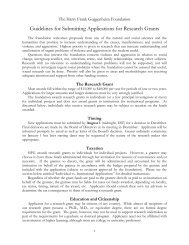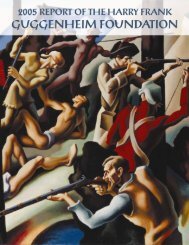Small Arms and Light Weapons - Harry Frank Guggenheim ...
Small Arms and Light Weapons - Harry Frank Guggenheim ...
Small Arms and Light Weapons - Harry Frank Guggenheim ...
- No tags were found...
You also want an ePaper? Increase the reach of your titles
YUMPU automatically turns print PDFs into web optimized ePapers that Google loves.
longs a conflict but also brings to a halt the economic,social, <strong>and</strong> political development needed tobring the conflict to an end. We see this phenomenonin other places. These cases need to beresearched <strong>and</strong> compared to produce findings thatcan be used by those charged with peace-building.governance<strong>Small</strong> arms have had notable destructive impactson the ability of some states to govern well. As discussedabove, proliferation has raised the cost ofmaintaining public order. This expense divertsresources from investment in the economy <strong>and</strong>diminishes a state's ability to help create jobs <strong>and</strong>raise the st<strong>and</strong>ard of living. In turn, all of this promotesthe acquisition <strong>and</strong> use of arms for bothlegitimate protection <strong>and</strong> illicit purposes by privatesecurity firms <strong>and</strong> individual citizens. Manywould argue that in some polities the state has foreversurrendered its role as the primary provider ofsecurity.Research has begun on the growth of privatemilitary contractors <strong>and</strong> its effect on societies. 15This work has demonstrated how private securitycompanies fuel the legal <strong>and</strong> illegal markets forsmall arms. In El Salvador, as in much of Central<strong>and</strong> Latin America, the state has lost its monopolyover the use of force <strong>and</strong> the tools of violence.These companies purchased mostly high-caliberweapons for their employees, which probably representeda good share of the more than 50,000firearms El Salvador imported between 1996 <strong>and</strong>2000. At the same time, it has been documentedthat 25 per cent of the weapons confiscated by theSalvadoran authorities were taken off of privatesecurity agents outside hours of work. 16 In recentyears the numbers of private security agents (some20,000 plus) have surpassed the 16,000 police officersserving in El Salvador. 17Such widespread availability of guns <strong>and</strong> abreakdown in the rule of law have led to the emergenceof private armed groups in many countries.Such groups are seldom held accountable for therole they play in human rights abuses. Indeed,small arms have become the weapons of choice notonly for political insurgents but also for terroristsaround the world. Nearly 75 percent of the significantterrorist incidents in 2002 were perpetratedby individuals <strong>and</strong> groups wielding small arms.<strong>Small</strong> arms create <strong>and</strong> fuel the conditions in whichterrorist groups thrive. The poverty <strong>and</strong> desperationexperienced by many post-conflict societiesare often exploited by terrorists, who use the victims'suffering to justify <strong>and</strong> build support for theiractions. Afghanistan in the 1990s provided suchan environment. Al Quaeda found there a safehaven <strong>and</strong> could tap into the vast criminal networksthat spring up in the absence of effective lawenforcement.The availability <strong>and</strong> use of firearms are determinedby the nature of governance in a country.The reverse is also true: firearms influence the waysin which countries are governed. The relationshipbetween firearms <strong>and</strong> governance is extremely significantfor development, law enforcement, <strong>and</strong>human rights, but it is underresearched.There is now a consensus typology of the effectsof the availability <strong>and</strong> misuse of small arms <strong>and</strong>light weapons, a picture that has emerged fromefforts of scholars working on one or another of themany aspects of the small arms problem. Table 1,from <strong>Small</strong> <strong>Arms</strong> Survey 2003, captures this consensus<strong>and</strong> serves as an excellent guide for furtherresearch.Notes1. Some of these accounts were the basis for a set offact sheets prepared by the U.S. <strong>Small</strong> <strong>Arms</strong> WorkingGroup (SAWG) in advance of the 2001 UN <strong>Small</strong> <strong>Arms</strong>Conference <strong>and</strong> updated for the 2003 Biennial Meetingof States follow-up conference. Fact sheets on smallarms <strong>and</strong> brokers; children; collection, destruction, <strong>and</strong>stockpile protection; development; human rights; internationalhumanitarian law; natural resources; peacekeeping;public health; tourism; <strong>and</strong> women can befound at http://www.iansa.org/documents/index.htm.18




